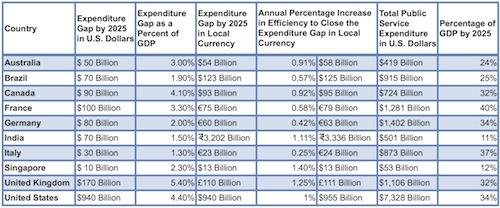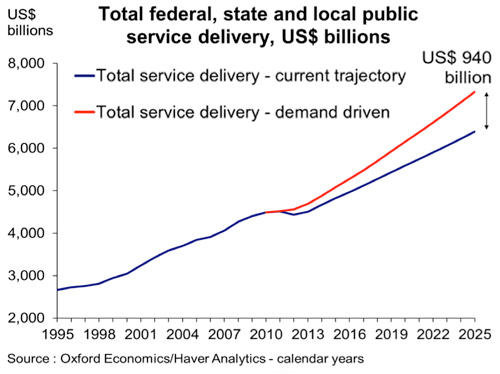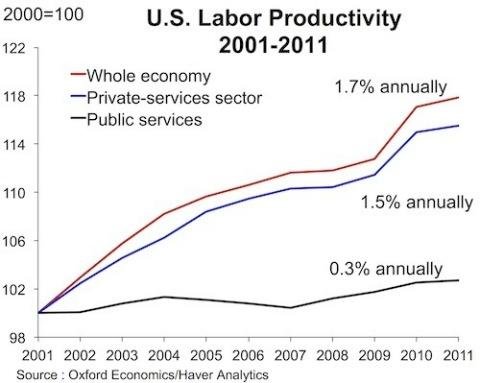Introduction
The purpose of this paper is to discuss the adoption and reforms of structured financial management techniques and then identify the manner in which such techniques affect the availability and delivery of public services in the United States of America. Creation of public value is a major goal of the public sector (Bandy, 2011: 17-23).
Bandy (2011) explains that people in the public sector especially at the managerial level face many challenges, demands and the need to achieve well defined goals. Having an in-depth understanding of the public sector, conceptualizing the need to constantly create public value and employing structured financial management techniques are core aspects in the success of delivery of public services.
Implementation of necessary financial management strategies and adoption of crucial business operations are crucial in the contemporary society. A number of public financial management and accounting standards that govern the United States of America’s public service do exist (Khopkar, 2004).
The United States of America has continued to experience many challenges in its attempt to effectively address the long-term financial demands of its citizens (Roberge, 2011: 119).
The United States of America, a developed nation, and an epitome of business success in the world is a country that does not receive both multilateral and bilateral financial assistance. Monitoring of the level of national liabilities and debt is a crucial aspect of financial management.
The said aspect if not accorded due attention could lead to a lot of financial and other related social and political problems to the country (Menzel & Harvey, 2011). The ever increasing trend by investors in the United States’ public debt sector and debt defaults poses a number of economic challenges. Moreover, the financial crisis has immensely contributed to America’s every increasing financial woes.
Smith and Licari (2011) elaborate on the fact that the United States and other developed and developing countries across the globe have increasingly adopted structured financial management strategies. However, a number of challenges still abound.

Source: Newsroom. Future Demand for Public Services, Driven by an Aging Population, Will Cost the U.S. Government an Additional $940 Billion by 2025, According to New Accenture Report. Web.
Some of the major challenges exhibited in the United States financial market relate to the lack of accountability and transparency of the government and very poor national financial management strategies (Mathur, 1997: 33-52). Others are the inexistence of public sector monetary reporting and a lot of deficiency levels of fiscal management in national public institutions.
Structured financial management techniques
Previously in the United States, there have been no specific monetary development programs.
The structured and streamlined financial management procedures that have been implemented in the United States have continuously been focused on improving the level of efficiency in the financial sector, encouraging effectiveness in the manner in which business organizations operate and accountability in the administration and use of the existing and potential public resources.
According to Khopkar (2004), such procedures have had a major long-term impact on the delivery of public services to U.S citizens. Unlike in most countries, public services in the United States are mainly provided by the private sector.
Structured financial management in the U.S is a multifaceted concept. In the United States and many other developed nations, structured business management has become more popular in liquidity transactions. This is in line with the management of the recent Wall Street challenges and the global financial crisis. Bandy gives an elaborate critique and relevance of the significance of the structured means of managing finances.
Structured financial management has continued to be a major nightmare in the economic sector of the country (Bandy, 2011: 14-39). Due to the implementation of the structured financial management techniques, provision of public services is mainly done by private investors though such investors are strongly monitored and controlled by the U.S public utility commissions (Menzel & Harvey, 2011: 17-21).
Implementation of sophisticated financial arithmetic, complex security instruments and contract designs have continued to hasten development and economic transparency in the business arena.
In the United States, efforts to develop, implement and streamline structured financial management have always been encouraged by the ever increasing financial challenges and the need to transfer credit risks likely to be experienced in the country (Cauchon, 2009: 12-23).

Source: Newsroom. Future Demand for Public Services, Driven by an Aging Population, Will Cost the U.S. Government an Additional $940 Billion by 2025, According to New Accenture Report. Web.
Besides the use of credit derivatives such as CDSS, Cropf (2011) explains that apart from financial institution securitization of credit facilities and implementation of more reliable financial development programs, the United States has been on the forefront among both developed and developing nations in enhancing faster and steady financial market growth and development.
This is evident in the structured manner in which the country’s financial sector is managed and the way the public sector operates. According to Dubois and Fattore (2009: 711-724), securitization of credit risks in the United States has also been enhanced by the undergoing regulatory arbitrage undertaken under the Basel 1 category of the country’s public service.
Under the existing structured financial management in the United States, a number of risk management issues do exist. These issues are either directly or indirectly related to the U.S structured financial market. In fact, rating of financial agencies has become a profound and very critical approach used in the country to effectively manage financial matters and streamline business processes.
Some of the unique long term financial vehicles being employed include loans, insurance contracts and asset backed securities such as CDOs and ABCP. The U.S government has also focused on planning and strategizing on the pricing of very complicated yet strategic financial opportunities in the country.
As a result, effective management and implementation of regulatory financial measures have continued to be key aspects of the United States’ money market (Menzel & Harvey, 2011: 9-35; Fry 1989).
To reinforce the success of the implementation of structured financial management strategies in the United States of America, several issues must be addressed. One such issue relates to the management of the Risk Management Authority.
To that end, Jeong and Nor (2007) are of the view that organizational chief risk managers need to be accorded more managerial powers that would enable them to effectively monitor, measure and critically analyze risks that would otherwise hinder the country’s overall economic development and growth.
Rigorous analysis of all major financial transactions also needs to be addressed with the most appropriate data, management of models necessary for the rating, testing and pricing of financial products in the market being employed.
Software applications for planning, cost forecasting and risk management approaches are some of the common structured financial management techniques used in most states in the U.S., albeit in an indirect manner (Sheila & Schultz, 2011: 54-62).

Source: Newsroom. Future Demand for Public Services, Driven by an Aging Population, Will Cost the U.S. Government an Additional $940 Billion by 2025, According to New Accenture Report. Web.
Different states of the U.S use varied models and statistical data in their projection of their labor productivity levels. This approach is important as it helps in the prediction of the manner in which financial structures of the organization are managed and business processes undertaken. Complexity in this model emerges due to the varied demands and operational mechanisms of the many states of the U.S.

Public sector and financial management
The U.S federal government has managed to effectively offer attractive, reliable and risk-adjustable financial returns (Roberts, 1999). The structured financial management has also enabled the U.S not to engage in unnecessary debt agreements and financial sectors that are a mere burden to the U.S public. Effective budgetary control and allocation are crucial in enhancing the overall wellbeing of the U.S public service sector.
The U.S public sector financial management is focused on fully implementing structured financial techniques. The techniques focus on ensuring that the delivery of public services is constantly improved (White & Guy, 1994: 34-39).
Effect of structured financial management techniques
Enhancement of a greater level of transparency and accountability in the business sector is important. In the United States of America, effective risk management strategies have been formulated with the aim of streamlining business operations.
Forecasting risk levels has ensured that risk management is made more effective and that services being rendered to the public are streamlined. Though sometimes complicated, the structured financial management methodologies have proved to be very significant in the overall improvement of the U.S economy (Cropf, 2011: 9-15).

Large U.S financial organizations foster efficiency and high level of effectiveness in the manner in which public finances are managed. In the case of the United States of America, cost forecasting helps to fully conceptualize America’s financial position. As a result, both the federal and state governments initiate realistic financial goals, objectives and strategies.
In the United States of America, there has been an overall positive result of having low interest rate levels that have encouraged both local and international investors to do businesses in the country. Implementation of a structured financial management in the public sector of the U.S is significant.
According to Denhardt and Vinzant (2000), structured financial management helps the country and other developing countries to effectively offer business-pertinent solutions that can boost the level of efficiency and cost effectiveness in the manner in which business operations are done.
Cost forecasting and structured financial management techniques are very crucial and relevant as they help to project America’s financial position.
They help to aggregate economic and financial management, encourage fiscal sustainability, resource allocation and constant resource mobilization across all sectors of the national economy. With reference to the operational management in the business arena, economic development and financial management strategies have been relevant in the overall enhancement of budget management (Bandy, 2011: 75-138).
The strategies also enhance performance evaluation and that a high sense of accountability and profitability are realized in all national investments (Paramasivan & Subramanian, 2009: 78-123).The strategies have further improved financial management which focuses on the fiscal sustainability, resource allocation and streamlined resource mobilization strategies. The latter encourage better operational management.
This has been evident in the U.S through performance, budget management and value-for-money financial management mechanisms. With reference to governance, it has been possible for the business enterprises in the country to work towards enhancing good governance aimed at fostering a high level of accountability and transparency in all business deals (Sheila & Schultz, 2011).
Through the use of structured financial management and business operational techniques, it is possible for the U.S and other developing countries across the globe to effectively offer business relevant, cost effective, reliable and very streamlined first choice financial applications.
The two techniques can help a country to foster key financial strategies and values such as innovation, creativity, integrity, constant development of business opportunities and accountability across all levels of the government. They also help to diversify financial services being rendered to the public.
They promote establishment of stringent financial techniques that in turn shape the degree to which one understands core financial drivers in the country and the accompanying economic opportunities for long term financial success (Kettl & James, 2009: 98-105).
As evident in the United States’ money market and the management of the country’s business environment, fiduciary risk management is also made easy when structured financial risk management is enhanced.
Existing evidence
Planning software, management of risk and cost forecasting are three structured financial management approaches used in most American states. Their use is evidenced by the high sense of efficiency, cost effectiveness in most business operations and constant planning for the future wellbeing of the people of the United States.
In its quest for continued global financial dominance, the U.S federal government has heavily relied on the structured financial management mechanisms to boost its risk identification strategies. According to Sheila and Schultz (2011), the main reason for doing this is to enhance the availability and delivery of public service in the U.S. This is also evidenced by the U.S financial systems that have been very reliable and accountable.
The evidence of this argument is also based on the fact the United States of America’s civil service is made up of both the exempted and competitive service sectors. The diplomatic service sector which is modeled on the existing national civil service systems only operates with the view of enhancing strong global diplomatic relationships.
In the U.S., evidence on the effective implementation of structured financial management technique is currently not as common as it would be expected.
Though some of the main drivers for change have been hindered or indirectly affected by issues such as the constant undertaking of reforms in the public financial sector, existence of deficits in people’s skills levels has led to the full implementation of structured financial techniques (White & Guy, 1994: 29-43).
This is evidenced by the United States’ financial system which has continuously been unable to comprehensively account for its use of public money.
Constant transformation in most public service sectors in the existing and emerging markets is proof of how best the adoption and reform of structured financial management techniques have affected the availability and delivery of public services by the federal government of the U.S. corporate values such as efficiency, effectiveness, transparency and accountability are evident in different public sectors.
The sectors include the U.S justice system, human services, revenue, postal agencies, defense and public safety (Jerome & Howard, 1998: 38-62).
The U.S public sector has continued to witness a steady shift in the manner in which public services are delivered. For instance, through structured financial management in the U.S, the country has continued to experience a shift from the use of standardised services to personalised ones.
By being insight driven rather than driven by reactive means, the United States of America has continued to be transformed for the better. As the existing evidence of the impact, the U.S economy has continued to be driven by public entrepreneurship since both the federal and the state governments no longer fully depend on rigid and unstructured financial management (Roberts, 1999).
As a result, the United States economy is no longer in form of piecemeal effiency but rather a mission oriented economy.
Transparency and accountability
It is crucial for U.S states and federal governments to employ structured financial management techniques with the view of tackling the challenges of cost and quality. Such challenges hinder the availability and delivery of public services in the country. There exists an unmatched level of openness, efficiency and accountability in the public services offered by the U.S government.
Besides the management of state and federal resources, adoption and reform of structured financial management techniques have highly contributed to the effective flow of information in various government structures of the U.S. Consequently, high levels of efficiency and cost effectiveness have continued to be realized in the U.S Wall Street and other financial sectors.
This has also been boosted by the participatory and collaborative manner in which all levels of the U.S government are integrated more so in the financial and public sector perspectives (Berezin, 2005; Clark, Reed, Stephan 2010).
It is evident that the adoption and overall reform of structured financial management techniques has led to the establishment of a new focus on how best to improve public service productivity. To enhance transparency and accountability, there has been segmentation of the U.S public into states and caucuses based on the specific needs.
This has led to a shift in the structure and delivery of fundamental public services needed by the public of the U.S (Patricia, 2010: 45-147). This relates to the U.S government’s continued attempt to have an in-depth understanding of the structured financial market. There has been an overall emphasis by the United States of America’s government for all public servants to offer high quality services that are truly valued by citizens.
Sadly, complaints against substandard service delivery, high cost of service, lack of transparency in some public sectors, poor service delivery and ineffective customer relationship still abound. As a means of enhancing transparency and accountability, the federal government focuses on enforcing reliable recruitment strategies (Smith & Licari, 2011).
Being the single largest employer in the public sector, the federal government uses very structured money management techniques in order to enforce fair workplace money management techniques.
Public sector reforms in the United States are in line with the federal policies on money management. It is also clear from the manner in which the public sector of the U.S is run that the delivery of public service aims at executing streamlined business processes and integrating all financial management techniques (Jerome & Howard, 1998: 47-56).
The projection also involves determining the level of efficiency and accountability standards necessary to ensure that all aspects of the delivery of public services are made better and more appropriate.
As explained by Moeller (2007), the existence of a high sense of efficiency, cost effectiveness and reliability of most of the services rendered to the public by the public servants indicate the high level of efficiency met by the public service of the U.S government.
Conclusion
Having a structured means of delivering public services is arguably a good means of enhancing efficiency, transparency, accountability and fostering public trust (Diane, 2008). Lack of efficiency and poor understanding of the manner in which the public sector operate poses many accountability challenges.
The U.S government needs to be focused on integrating the public sector and other operative mechanisms in order to fully win public trust. In line with the analysis, my stand is that structured financial management techniques are very significant in the running of the U.S public system.
I also believe that existence of a high level of transparency and accountability in the management of financial matters is crucial as it boosts public confidence in government of the day.
The above analysis indicates that incidences of rampant losses in the public financial sector, unclear strategies of resource allocation, unmonitored and unclear auditing, accounting systems and use of weak legislative framework are major challenges faced in the delivery of public services in the different states of the U.S.
Since the availability and actual delivery of public service in the U.S are highly dependent on the level of efficiency, reliability and accountability of financial management techniques, the U.S government needs to implement proper planning of public services. This could be done by adopting modern technologies and information systems that streamline business processes.
Public services should be people oriented and where possible, the government should privatize and keenly monitor the manner in which public services are delivered. Implementation of monetary development programs that are in line with the structured financial management approaches that are currently in use is crucial.
As evidenced by most arguments made by Bandy (2011: 34-45) on financial management, efforts to ensure that steady economic growth and effective delivery of public services should be made. This should be done by both the state and the federal governments.
The two should focus on implementing fair resource allocation, fiscal sustainability and restructured resource mobilization. Above all, the state and federal governments should collaborate in ensuring that they fully implement the necessary public service reforms.
References
Bandy, G. 2011, Financial Management and Accounting in the Public Sector, Routledge, London.
Berezin, M. 2005, “Emotions and the Economy” in Smelser, N.J. and R. Swedberg (eds.)The Handbook of Economic Sociology, Second Edition, Princeton University Press, Princeton.
Cauchon, D. 2009, Richest of Federal Workers Get Richer, Florida Today, Cengage Learning, Connecticut.
Clark, V., Reed, M. & Stephan, J. 2010, Using Monte Carlo simulation for a capital budgeting project, Journal of Management Accounting Quarterly.
Cropf, R. 2011, American Public Administration: Public Service for the 21st Century 5th,Ed, Pearson Longman, London.
Denhardt, R. & Vinzant, D. 2000, The New Public Service, Serving Rather than Steering, Public Administration Review 60 (6).Jossey-Bass, New York.
Diane S. 2008, Global Public Policy, Transnational Policy Communities and their Networks, Journal of Policy Sciences.
Dubois, H. F. & Fattore, G. 2009, International Journal of Public Administration, Routledge Taylor & Francis Group, New York.
Fry, B. 1989, Mastering Public Administration; from Max Weber to Dwight Waldo, Chatham, Chatham House Publishers, Inc., New Jersey.
Jeong, C. & Nor, F. 2007, Principles of Public Administration: An Introduction, Karisma Publications, Kuala Lumpur.
Jerome, B. M. & Howard, L. 1998, Public Administration: Balancing Power and Accountability 2nd Ed, Praeger Publishing, Westport.
Kettl, D. & James, F. 2009, The Politics of the Administrative Process, CQ Press, Washington D.C.
Khopkar, S. M. 2004, Environmental Pollution Monitoring and Control, New Age International, New Delhi.
Mathur, P. N. 1997, The Civil Service of India, 1731-1894: a study of the history, evolution and demand for reform, Pearson Longman, London.
Menzel, D. & Harvey, W. 2011, The State of Public Administration: Issues, Challenges and Opportunity, M E Sharpe, New York.
Moeller, R. 2007, COSO Enterprise Risk Management: Understanding the New Integrated ERM Framework, John Wiley Sons Inc, New Jersey.
Paramasivan, C. & Subramanian, T. 2009, Financial Management, Prentice Hall, Oxford University.
Patricia, E. 2010, The Cambridge Illustrated History of China, Cambridge, 2nd Ed., 45-147, Cambridge University Press, London.
Roberge, E. 2011, Whythegovdoesnotwork.com SNAFU, A Hysterical Memoir About Why the Government Doesn’t Work, FL: Createspace, Bureau Publishing, Orlando.
Roberts, J. 1999, A. Concise History of China, MA: Harvard University Press, Cambridge.
Sheila, K. & Schultz, S. 2011, American Public Service, Constitutional and Ethical foundation, Jones and Bartlet Learning, New York.
Smith, K. & Licari, M. J. 2011, Public Administration – Power and Politics in the Fourth Branch of Government, Cengage Learning, Connecticut.
White, J. & Guy, A. 1994, Research in public administration: reflections on theory and practice, John Wiley & Sons, Inc., New Jersey.